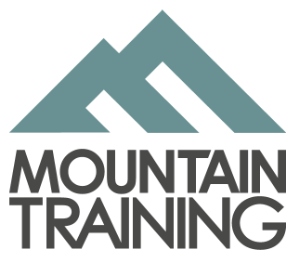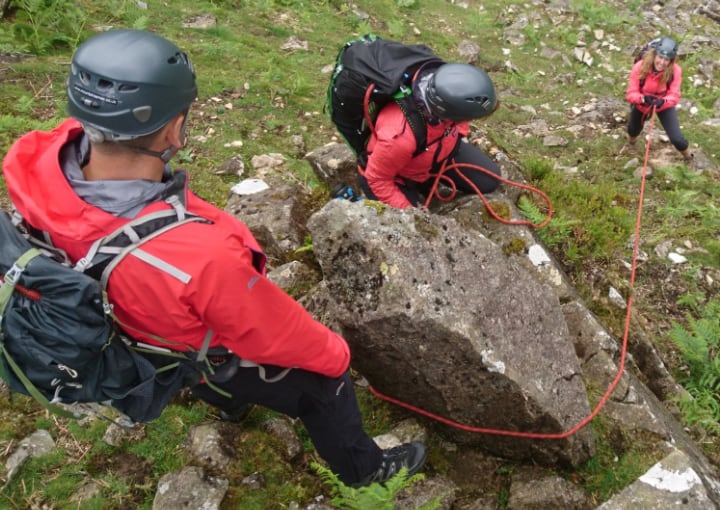The ability to look after a group whilst negotiating a section of steep ground during a mountain walk requires lots of practice, experience, good judgment and confidence. A Mountain Leader must be equipped with a range of skills and strategies to lead a group safely and efficiently. If the leader does not feel comfortable personally, on a particular section, it is best to go elsewhere.
Typically in the UK an ML could have to deal with the following types of challenging terrain: Steep vegetated slopes – Scree – Boulder fields – Short rock steps – Exposed ridges – Loose Gullies – and combinations of any of these. Personal experience of such terrain, judgement and planning ahead gives us the best foundation on which to build our strategies and techniques for leading.
There is no substitute for broad mountain experience in proving a good ML with the ability to operate with confidence on steep, challenging ground. The ability an ML to introduce clients to these aspects of the mountain environment can often provide the richest and most memorable experiences.
Route choice
This should begin beforehand with the map or local knowledge, should account for weather conditions, conditions underfoot and ability level within the group. During the walk into an area of steep and challenging mountain ground consider the overall ‘line of least resistance’ through the terrain, as well as the ‘micro’ choices as to where you will actually step - this latter decision may require you to stop the group and scout ahead whilst you risk assess your options. Where important route selection features are visible from the walk in such as prominent outcrops, gulleys, boulder fields etc these should be memorised. This will support efficient route choices during the period of travel through the section of steep and challenging ground.
Choice of leadership and group management strategy
Position relative to the group; group order; group spacing; position of maximum effectiveness (POME) for protecting an awkward section; whole group moving at once; one at a time; allowing group to continue ahead. Whatever your strategy comprises, key decisions should be made before you tackle each steep ground challenge and be prepared to alter it if the situation demands it.
Dynamic Risk Assessing – your in built ‘danger radar’
Always be asking yourself what is the LIKELIHOOD and what is the CONSEQUENCE of a slip or a trip. Likelihood is largely based on difficulty, ability, footwear, experience, environmental conditions and fatigue. Consequence is dictated by the nature of the terrain below. Astute monitoring of your clients is crucial in exposed situations, not only to keep them on the desired route, but also to check that their footwork, balance and confidence (body language) is sufficient for the terrain. These considerations will help the ML to decide whether CONTROL MEASURES are required to address the risk of serious harm affecting the group.
The three processes above are ongoing in the leader’s mind whilst in steep ground. The following strategies should be ready to deploy when they are judged to be necessary.
Coaching (verbal assistance)
It may be necessary and prudent to give some coaching to a group before they are actually on steep terrain, where valuable techniques can be taught and practiced in relative safety. Body position, balance, foot placement and effective use of boots, what to stand on and what to avoid are among the many aspects our clients may need help with. By positioning ourselves where we can observe how individual clients are performing (this may be at the back) we can then give extra coaching if needed. A key decision concerns the benefits of the ML changing leadership position within the group. We may also choose to coach each group member over a difficult section from a static position.
Reassuring (psychological assistance)
If we have identified a client who appears tentative on steeper terrain it may be appropriate to simply stay close and give a few words of encouragement at certain points. It is vitally important that the leader does not become too focussed on that individual and neglects the rest of the group.
Spotting (close-proximity physical assistance)
Effective spotting on a short rocky step is a difficult and serious skill in its own right. This is not something to do in a half-hearted manner. You must be satisfied you are in a stable and secure position, from which you can realistically guide a falling client down to the ground or ledge and that there is no possibility that you or they could fall further. Spotting can be regarded as helping a walker land on their feet rather than toppling backwards and increasing the risk of injury. A hand pre-placed on a rucksack is able to instantly apply force to the client to achieve this. As a rule of thumb, a gap of more than a few inches from your hand would allow a falling client to gather more momentum than you could control. Once past the step, the group members may have to wait for you out of sight, so identify any further hazards and consider in what order you may want to send them.
Using a rope
The use of the rope is classed as an ‘emergency procedure’- a mountain leader should not plan a route that is likely to require the use of a rope in order to safeguard the group. Essentially, a leader could decide to use a rope to keep a group safe on a short section of exposed terrain where a slip is likely and the consequences are severe AND THIS STEP MUST BE CROSSED – i.e. there is no alternative route or other safer course of action.
Conclusion
Looking after a group in steep and challenging mountain walking terrain requires good judgment based on extensive experience of this type of ground. The leader will be constantly scanning the ground ahead using their ‘danger radar’ to identify the best route and potential hazards. Being able to read the ground effectively comes only with experience. Identifying and quickly risk assessing awkward sections and judging what controls can be put in place are essential skills for safeguarding groups in this terrain.


